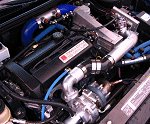Tuning
Your Turbo Saturn - Part 2
by: Qksl2
MONITORING YOUR BALLS
Here, I will attempt to somewhat briefly explain what you should
be
monitoring. You can't tune blindly, and you, just like your management
system, are an input/output device. This time, your car is the input,
you see what it is doing, and you generate and output to make the
car do what you want it to do. Your inputs are what the car does,
and you monitor these things through three key ways: Air fuel ratio,
EGT, and knock. Other inputs are the sound, smell, feel, and driving
characteristics of the motor. The gauges you need to have are a
wideband A/F ratio gauge and an EGT gauge. A knock sensor readout
is a very good idea as well, and nearly all other highly tuned turbo
cars (think DSM and supra) use knock readouts as a way to tune.
Your wideband is to your fuel tuning as your EGT gauge is to your
timing tables. Your knock is an umbrella, which is affected by both.
That's not to say that a hot EGT reading means you are running too
little
timing, or visa versa. Unfortunately, it isn't that simple.
IGNITING MAH ASS
Boost makes cylinder pressure. Cylinder pressure makes the piston
move. The piston moving makes torque. Torque makes power. Boost
makes power. Fuel is just there to allow there to be a controlled
ignition of the charge (air read: boost) and spark just sets things
off before they set off on their own. Oversimplified? Horribly.
True? For the most part. So if boost is what makes power, what does
timing do? Traditionally, it is thought that 17 degrees past TDC
(top dead center) is where you want peak cylinder pressure to be.
You have the most "leverage" to do maximum work with limited
energy (read: intake charge). With a steady burn rate of a naturally
aspirated motor, most old almost dead dudes have figured out that
about 35 degrees of advance gets peak cylinder pressures around
17 degrees past TDC. Let me try to explain this so more people will
understand: You want maximum "kaboom!" when the piston
is 17 degrees past TDC. There, the piston is in the part of its
stroke where it will make most
efficient use of the pressure in the combustion chamber. Here, I
won't explain why this is, so just believe me or I'll ban your jap
ass. So to get maximum "kaboom" at 17 degrees past TDS,
or ATDC (after top dead center), it is conventionally thought that
35 degrees of timing advance is best. That means that the spark
happens at 35 before… and by the time that the maximum pressure
from the expanding "kaboom" happens, the piston is at
17ATDC. Got it? The flame front speed and
maximum pressure along with the combustion chamber shape, fuel octane,
and other factors will determine how long it takes after the spark
for maximum cylinder pressure to happen, so how much advance is
needed to make maximum pressure occur at 17ATDC will vary depending
on conditions. When we add forced induction into the mix, pressures
will vary, and the spark advance for peak performance efficiency
will vary wildly as well.
Of course, this is all very general engine workings… and mostly
applies to V8's non v-tak MDM (Mexican domestic market, we don't'
make most yank cars in the United States Of W's Ass any more). So
be that as it may, what does this mean to
us? Well, this basically doesn't apply. Why did I explain it to
you in simple terms, then? Because you need to understand that before
you can attempt to understand how to set timing for our cars. Most
small displacement high boo…. Wait, let me say this, first.
Given each and every setup, there is a maximum allowable cylinder
pressure (most heavily determined by the map or load/boost value)
that a certain cylinder can take at a certain RPM before pre-ignition.
Pre ignition just being that the mixture or intake charge "kabooms!"
before it is supposed to. Don't know what that is, look it up. Think
pink, knock, or detonation. So there is a certain amount of pressure
that the cylinder can take before it prematurely "kabooms!".
Recall that the idealized 35 degrees of advance also gets us maximum
efficiency for each "kaboom!". So combine maximum cylinder
pressure with maximum efficiency and you get mad 3rd gear v-tak
power, right? Yes, in a perfect world. However, we'll never get
to that point. Not in my yellow life, anyway. Small displacement
high boost cars will knock before you get to 35 degrees of advance
under boost. Generalization? Yes. So sue me, ACLU. Reality though,
seriously. Point is, we'd make a lot of power by running 35 degrees
of advance and boost, but it's unlikely our cars can even run 35
degrees of advance with no boost on pump gas. Throw in a whole crap
load of potential energy that is boost and you have a "kaboom"
that'd make Hiroshima jealous.
So what do we do? We run as much advance as we can without things
going "kaboom!" before they are supposed to. That means
we get peak cylinder pressures as close to 17 degrees ATDC as possible.
The effect on the power output of a motor with small timing changes
is huge, as you can imagine. As you move peak cylinder pressures
closer to optimal range, you can increase your power immensely.
In fact, dropping the boost and increasing timing is probably most
overlooked way of picking up horsepower there is. You run less peak
dynamic pressures and lower your EGT's, while picking up horsepower,
dropping your BSFC (look it up), and running a cleaner combustion
process. Too good to be true? It's not, its just not experimented
with, much. That's how we have hugely overboosted turbo 4 cylinders
making some pretty pathetic numbers.
Setting timing. Saturns seem to like around 15 degrees at idle.
Drop the idle down to 800rpm or so from 1000 and they like about
13. You can time an engine at varying RPM's by listening closely
to the sound. It is very hard to describe, and is something that
you'll learn with experience. When timing is too retarded, it will
sound softer, with slower, longer exhaust pulses and a "rounded"
tone. The gaps between each exhaust pulse will be longer, and it
will sound lopier, or more like it has a hot cam. At the exact same
RPM, the correct timing will sound smoother, and the engine will
shake less on its mounts. The tone between each cylinder firing
will
change less. When you add too much timing, you'll hear a sharper
"crack" for each firing. When you tip into the throttle,
it will try to respond quickly but misfire because the VE of the
motor cannot keep up with the spark, in layman's terms. You want
timing to slowly ramp up until the engine "clears its throat".
There, you want to carry maximum timing until your start building
significant boost, where you'
ll be forced to start backing off timing. Where you get maximum
boost and torque lowest in the RPM band, you'll want to be most
conservative with timing. As torque starts to drop off and cylinder
pressures die down due to pumping losses at high RPM (read: restriction),
you can usually add more timing. If you have you're a/f set pretty
conservative and you are getting high EGT's, your first step will
be to drop the boost until EGT's come down to a reasonably level.
Now, at that same boost level, advance the timing while watching
knock carefully, and ensure that you have not altered the a/f ratio
by changing the boost. Watch carefully; if there is a reduction
in EGT temps by adding timing, then you had taken out too much timing.

Skip to page 1,
4
|



The turbosaturns.net
forum has become one of the best resources for Saturn performance
on the net. Our members are constantly pushing their cars to new
performance levels. So, log in, share your ideas, and help push
your car’s performance to the next level.

Archived Articles

August 2005 TSN will be holding its first ever meet
in Chardon, Ohio. Some of the fastest Saturns in the country will
be attending. Activities will include drag racing, dyno, tech session,
and BBQ. Look for the latest information in the forums.

Different
Racing

Jeff and his team Different Racing have big plans
on breaking into some really low quarter mile times this year. Last
year he posted a 12.40 on a pretty healthy nitrous shot. This year
he has a new turbo setup and some serious determination. Visit his
website for the latest news and information. I expect we'll be seeing
some low 12's from him by the end of the year.
|






